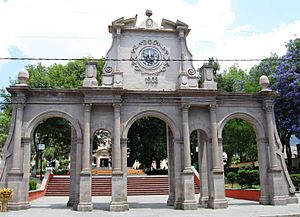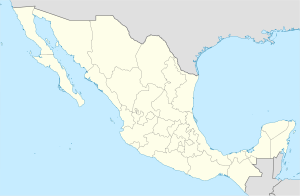Temascalcingo facts for kids
Quick facts for kids
Temascalcingo
|
|
|---|---|
|
Municipality
|
|
 |
|
| Country | |
| State | State of Mexico |
| Municipal seat | Temascalcingo de José María Velasco |
| Founded | 1826 |
| Elevation
(of seat)
|
2,260 m (7,410 ft) |
| Population
(2005) Municipality
|
|
| • Municipality | 58,169 |
| • Seat | 11,454 |
| Time zone | UTC-6 (Central (US Central)) |
| • Summer (DST) | UTC-5 (Central) |
| Postal code (of seat) |
50400
|
| Area code(s) | 718 |
| Website | www.temascalcingo.gob.mx |
Temascalcingo is a municipality in the State of Mexico, Mexico. The main town, called Temascalcingo de José María Velasco, is its center. You can find it in the northwest part of the state. The name Temascalcingo comes from the Nahuatl language. It means "place of the little temazcal," which is a type of traditional Mexican steam bath. This town is also known as one of the "Pueblo con Encanto" (Towns with Charm) in the State of Mexico.
Contents
Discover Temascalcingo Town
A Look at History
People have lived in the Temascalcingo area for over 10,000 years! The first known group was the Mazahua. They called the area "Ñiñi Mbate," which might mean "place of the small plain." Before the 1500s, the Aztecs took control of this area.
When the Spanish arrived, the Mazahuas and Otomis here joined the Aztecs to fight them. But the Spanish won, and in 1540, Hernán Cortés gave this land to Francisco de Villegas. Around 1535, Franciscans (a group of priests) came to teach Christianity. They built churches and renamed the area San Miguel Temascalcingo.
In the 18th century, large farms called haciendas grew lots of grain. This grain was sent to mining towns nearby. When the Mexican War of Independence started in 1810, people here quickly supported the fight for freedom. After the war, the State of Mexico was created in 1824. Temascalcingo became its own municipality in 1825.
In 1912, a big earthquake caused damage in the area. The town changed its name to Temascalcingo de José María Velasco in 1945. This was to honor the famous painter José María Velasco Gómez, who was born there. Even with the longer name, most people still call it "Temascalcingo."
Temascalcingo Today
The town sits high up, about 2,380 meters (7,800 feet) above sea level. In 2005, about 11,454 people lived there. The town's heart is the Plaza Centenario, a central square. The Municipal Palace, where the local government works, is on the south side of this square. To the north, there's a smaller square honoring painter José María Velasco.
On the west side of the main plaza, you'll find the Parish of San Miguel Arcángel. This church was rebuilt in 1939. It has a beautiful Neoclassic style, made from pink stone found in the region. It has one tall tower with a clock. Inside, the altars are made of mahogany wood. In front of the church is a large park area.
The Centro Cultural José María Velasco is a cultural center. It celebrates the art of José María Velasco, who was famous for his landscape paintings. He often painted nature scenes from central Mexico. There's also the José María Velasco Nature Park at the town's entrance. This park has forest areas, playgrounds, and a small pool for visitors to enjoy.
Local Food and Fun Events
When you visit, try some local dishes! These include chicken in "chirrión" sauce, cactus with green salsa, and "mole de olla" with xoconostles (a type of fruit). For drinks, try "puscua," made from corn, or "sende choo," a Mazahua drink from fermented corn. You can also find pulque, often flavored with fruits like cactus pears.
Many special events happen in Temascalcingo. From December 31 to January 1, Mazahua and Otomi pilgrims visit. They celebrate the "Lord of the Coronation" with decorated images of the saint. Music from flutes, mariachis, or drums fills the air. You can see traditional dances like "Las Pastoras" and "Los Concheros." On January 1, there's a procession to the church.
Every year since 1975, a passion play takes place. Young men act out the crucifixion of Christ. The Feast of Corpus Christi in June also features large processions. On August 16, there's a local festival for "Lord Ndareje" or "Lord of the Water." Ancient rituals happen at the Los Pastores waterfall, and offerings are left in the Lerma River.
Famous People from Temascalcingo
Temascalcingo has been home to several notable people:
- José María Velasco Gómez (1840–1912): A very famous landscape painter.
- Archbishop Leopoldo Ruiz y Flóres (1865–1941): An important church leader who faced exile during a time of conflict in Mexico.
- María del Carmen Garduño Cervantes (born 1955): A track-and-field athlete who won medals and set Mexican records.
- Pinito Reynoso Bejarano (1895–1981): An educator known for helping people learn to read and write.
Images for kids
Exploring the Municipality
The town of Temascalcingo de José María Velasco is the main center for the entire municipality. This means it oversees many smaller communities around it. Temascalcingo shares borders with other municipalities like Acambay, Atlacomulco, Jocotitlán, and El Oro. To the west, it borders the states of Michoacán and Querétaro. In 2005, the whole municipality had a population of 58,169 people.
There are some interesting places to visit in the municipality:
- The Tzindo: This is an archaeological site with ancient cave drawings. It's like a peek into the past!
- The Hacienda de Solis: A historic large estate from the colonial period.
- "El Borbollón": About 18 km (11 miles) from the main town, this is a natural spring. It's officially called the "Spring of Jesus." The water is naturally heated by volcanoes and has many minerals. It forms a pool where you can relax.
See also
 In Spanish: Temascalcingo de José María Velasco para niños
In Spanish: Temascalcingo de José María Velasco para niños





